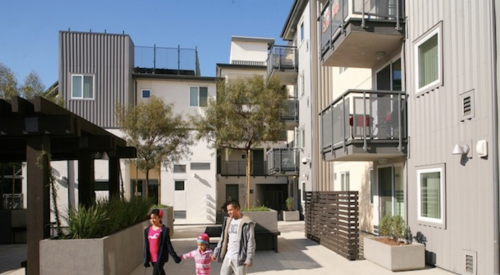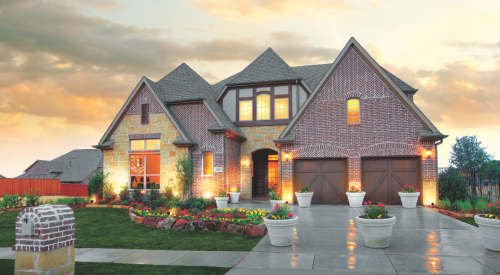When a landowner’s plan to develop a New Rochelle, N.Y., estate fell through, Ginsburg Development Corp. bought the 17-acre site and revised the plan to bring Kensington Woods to reality. The result: an empty-nester enclave of 52 luxury homes.
Vital Stats
Developer/builder/land planner: Ginsburg Development, dba Ginsburg Development Corp.
Architects: Jas St. Jean, John Karhu, Joseph Garcia and GDC in-house
Community size: 52 units on 17 acres
Pre-sales started: June 2003
Models opened: August 2003
Sales to date: 27
Home type: Single-family detached
Number of plans: 5
Square footages: 2,850 to 3,500
Price range: $1 million to $1.275 million
Buyer profile: Active adults, 50+, no children
Niche Market Opportunity
It’s difficult to find a 17-acre parcel in lower Westchester County, which has been all but built out for decades, says Steve O’Brien, GDC’s director of development. GDC bought this parcel after the previous landowner, an individual investor who lived next to the property, took about four years in the late 1990s to get approval for a land plan calling for 53 detached single-family homes. He sold the land to GDC in September 2001 after failing to meet bonding and other requirements common to lone investors because of their lack of resources.
Conversely, GDC has spent 40 years designing and building for-sale, rental, office and retail properties. While detached single-family projects historically have composed less than 10% of GDC’s business, O’Brien says Kensington Woods “afforded us an opportunity to create a high-quality luxury community of detached homes targeting a specific market” — the kind of niche product the company seeks.
Overcoming Obstacles
New Rochelle wanted an empty-nester community of detached homes for families without schoolchildren. The city school district’s current budget allots $14,303 per student annually, and the city feared that multi-child households would siphon more tax dollars than new construction would generate.
“Communities all across the country are wrestling with concerns about schoolchildren,” O’Brien says, “and builders are wrestling with how to target active adults to address these concerns.”
New Rochelle’s “targeted” zoning for Kensington Woods banned steps leading to the front entrance, required first-floor master bedrooms, limited the number of bedrooms to three and mandated interior framing that would accommodate a future elevator. City planners also insisted on approval authority for all front facades to ensure a fit with the development’s up-market surroundings.
“There was huge amount of apprehension when we came in,” says O’Brien, because of city planners’ experience with the previous landowner, who failed to target the desired market or provide a suitable community design. In contrast, GDC submitted sketches with not just the required facades but also all exterior elevations. That built trust, and the planners had no complaints.
GDC, however, wanted bigger homes and lots than the original plan allowed, and the city feared that larger homes would attract larger families. But, O’Brien argues, “The size of the house is not the critical component, it’s the design. While our target buyers are empty nesters, they are affluent empty nesters. They entertain and want a lot of space.”
So the city approved GDC’s bid to reconfigure the land plan and increase lot size to accommodate homes a few hundred square feet larger. O’Brien did this by eliminating a recreation lot and a common area. GDC also suggested restricting yard use, banning children’s play equipment and adding finished elevators to the standard home plans. The city happily agreed.
The homes had to blend with the surrounding landscape but live like target buyers’ Sun Belt getaways. So O’Brien and principle Martin Ginsburg put hundreds of hours into the plan to blend the area’s aesthetic with less traditional open plans before leaving the details to outside architects.
“Buyers aren’t necessarily looking to downsize so much as move into a convenient, low-maintenance home,” O’Brien says. The homeowners association takes care of that with snow removal, lot manicuring and grounds keeping.
Kensington’s airtight homes are Energy Star-approved, which adds approximately $3,000 to GDC’s cost per home. “It’s not our primary selling point,” Ginsburg says. “We do this because if everybody builds to high energy-efficiency standards, it’s going to add up and help the country consume less oil. It’s about doing the right thing.”
The Outcome
Through February, GDC had closed 11 homes and had 16 more under contract, with delivery dates extending through 2004. Buyers have brought in only three teenage children, all of whom attend private school. Almost half of the buyers are retired or semiretired snowbirds who fly away for winter and rely on turnkey HOA maintenance.
“This is a unique site in a very developed community within falling distance [20 miles] from New York City,” Ginsburg says. “Yet we were able to do cluster, and the sites were from 10,000 to 15,000 square feet, which for this area is a complete anachronism.”
O’Brien calls the entire process “a little scary. The question on everybody’s mind was: Is there really a market for this in Westchester? But all of our gut instincts are proving out.”
Build-out is expected by the fourth quarter of 2005.
Resort Sensibility With a Traditional Touch
The traditional-meets-resort sensibility continues to the homes’ traditional interior touches, from trim and detailing to The Eton’s nontraditional open kitchen and living and dining rooms, which reflect the preferred lifestyle of many buyers — snowbirds with second homes in the Sun Belt. Columns and trim, which are standard, add luxury in white; wood options are also available.
A traditional New England aesthetic dresses Kensington Woods’ exteriors while the streetscape’s beech, hemlock, spruce, oak and maple trees lend an established air.
Complex roof lines translate into swooping lines and sense of space as visitors make a grand entrance into The Greenbriar. The dramatic ceiling lines necessitated conventional framing. No first-floor ceilings are lower than 9 feet in any of the community’s five plans.
Apprehensive city planners maintained approval authority over front facades, but GDC presented sketches of all elevations and followed through with well-designed elevations all around. Sophisticated luxury buyers are more likely to appreciate the effort than down-market buyers more inclined to make budget compromises that favor interior finish. An added convenience: patio access to the basement.
A city mandate limited bedrooms to three, leaving Ginsburg Development with plenty of flexibility in targeting multiuse room options to active adults. These include a wine cellar and a library with plenty of built-in cabinetry as well as media and exercise rooms.












